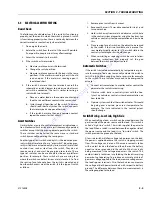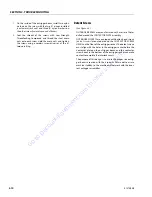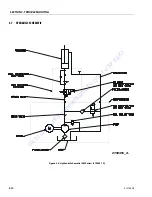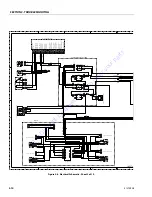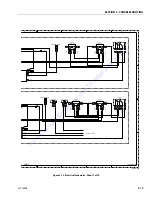
SECTION 3 - TROUBLESHOOTING
31215808
3-5
3.5
ELECTRICAL SWITCH TESTING
Basic Check
The following check determines if the switch is functioning
properly, not the circuit in which the switch is placed. A switch
is functioning properly when there is continuity between the
correct terminals or contacts only when selected.
1.
De-energize the circuit.
2.
Isolate the switch from the rest of the circuit if possible.
If not possible, keep in mind it may affect readings.
3.
Access the terminals to the switch.
4.
If the switch has two terminals:
a. Measure resistance across the terminals.
b. Change the switch position.
c. Measure resistance again with the leads in the same
positions. If the meter was reading short, it should
read an open. If the meter was reading open it
should read short.
5.
If the switch has more than two terminals, consult the
schematic or switch diagram to determine what termi-
nals will be connected. The test is similar to testing a
switch with two terminals.
a. Place one meter lead on the common contact and
the other on a different contact in the same circuit.
b. Cycle through all positions of the switch. The meter
should read short only when the switch connects
the two terminals and open otherwise.
c. If the switch has more than one common contact
repeat the process for that circuit.
Limit Switches
Limit switches are used to control movement or indicate posi-
tion. Mechanical limit switches are just like manually operated
switches except that the moving object operates the switch.
These switches can be tested the same way as a standard
switch by manually operating the sensing arm.
Another type of limit switch used by JLG is the inductive prox-
imity switch, also referred to as a "prox switch". Inductive prox-
imity switches are actuated only by ferrous metal (metal that
contains Iron, such as steel) near the switch. They do not
require contact, and must be energized to actuate. These
types of switches can be used to detect boom or platform
position, for example. These switches have a sensing face
where the switch can detect ferrous metal close to it. To find
the sensing face, take note how the switch is mounted and
how the mechanisms meet the switch. Test this type of switch
as follows:
1.
Remove prox switch from its mount.
2.
Reconnect harness if it was disconnected for step 1, and
turn on machine.
3.
Hold switch away from metal and observe switch state
in the control system diagnostics using the Analyzer. See
vehicle or control system documentation on how to do
this.
4.
Place sensing face of switch on the object to be sensed
by the switch. If that is not available, use a piece of fer-
rous metal physically similar to it. The switch state in the
control system diagnostics should change.
5.
When reinstalling or replacing switch be sure to follow
mounting instructions and properly set the gap
between the switch and object sensed.
Automatic Switches
If the switch is actuated automatically, by temperature or pres-
sure for example, find a way to manually actuate the switch to
test it. Do this either by applying heat or pressure, for example,
to the switch. These switches may need to be energized to
actuate.
1.
Connect instrumentation to monitor and/or control the
parameter the switch is measuring.
2.
Observe switch state in control system with the Ana-
lyzer. See vehicle or control system documentation on
how to do this.
3.
Operate system such that the switch actuates. This could
be going over a certain pressure or temperature, for
example. The state indicated in the control system
should change.
Switch Wiring - Low Side, High Side
When controlling a load, a switch can be wired between the
positive side of the power source and the load. This switch is
called a "high side" switch. The switch supplies the power to
the load. When a switch is wired between the negative side of
the power source and the load, it is a "low side" switch. The
switch provides the ground to the load.
A low side switch will allow voltage to be present on the load.
No power is applied because the switch is stopping current
flow. This voltage can be seen if the measurement is taken
with one test lead on the load and the other on the battery
negative side or grounded to the vehicle. What is actually
being measured is the voltage drop across the switch. This
could mislead a technician into thinking the load is receiving
power but not operating. To produce an accurate picture of
power or voltage applied to the load, measure voltage across
the load’s power terminals. Also, the technician can measure
the voltage at both power terminals with respect to battery
ground. The difference between those two measurements is
the voltage applied to the load.
Go
to
Discount-Equipment.com
to
order
your
parts















